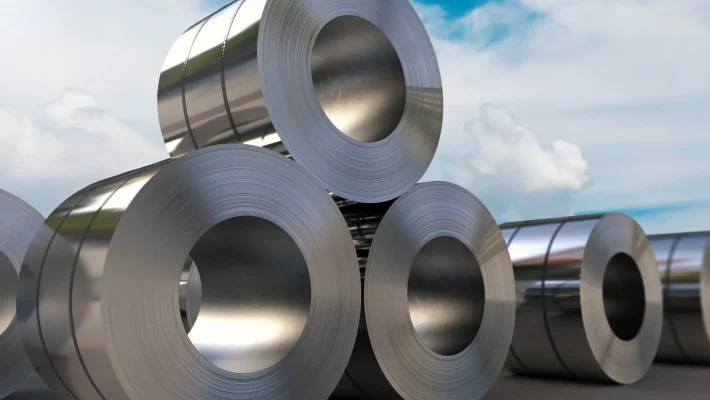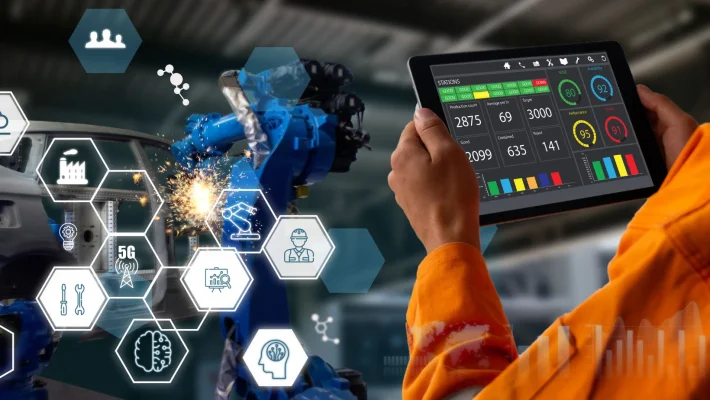Exploring the Benefits of MES: From Process Visibility to Data-Driven Insights
Table of content Understanding Manufacturing Execution Systems (MES) Challenges and Considerations Conclusion In the ever-evolving landscape of manufacturing, staying competitive and efficient is crucial. Manufacturers constantly seek ways to improve their operations, reduce costs, and enhance product quality. One technology that has gained prominence in recent years for achieving these goals is Manufacturing Execution Systems (MES). MES is a comprehensive software solution that bridges the gap between enterprise-level systems and the shop floor, providing a wide range of benefits, from enhanced process visibility to data-driven insights. In this article, we will delve into the world of MES and explore its myriad advantages to modern manufacturing. Understanding Manufacturing Execution Systems (MES) Before we dive into the benefits, it’s essential to understand what MES is and how it functions. MES is a software-based solution designed to manage, monitor, and control manufacturing operations on the shop floor. It acts as a bridge between the Enterprise Resource Planning (ERP) system, which manages the business aspects of manufacturing, and the Programmable Logic Controllers (PLCs) and other automation devices responsible for controlling machines and processes on the factory floor. MES focuses on real-time data collection and analysis at its core, enabling manufacturers to make informed decisions and optimize their production processes. Now, let’s explore the tangible benefits MES brings to the table. 1. Enhanced Process Visibility One of the primary advantages of MES is its ability to provide real-time visibility into manufacturing processes. It captures data from various sources, such as machines, sensors, and manual input, and presents it in a unified dashboard. This visibility gives operators and decision-makers a clear picture of what’s happening on the shop floor at any moment. With MES, you can monitor machine performance, track work-in-progress, and identify real-time bottlenecks or downtime. This level of visibility enables proactive decision-making, allowing manufacturers to address issues as they arise, reduce downtime, and optimize production schedules. 2. Improved Quality Control Quality control is a paramount concern in manufacturing. MES plays a crucial role in ensuring product quality by enforcing standardized processes and providing real-time quality data. It can track key quality metrics, such as defect rates, tolerances, and compliance with industry standards. By monitoring and analyzing quality data in real time, MES helps manufacturers detect defects early in the production process, reducing the likelihood of producing faulty products. This not only enhances product quality but also reduces rework and scrap, ultimately leading to cost savings. 3. Efficient Resource Management Resource optimization is another key area where MES excels. It helps manufacturers allocate resources, such as labor, materials, and equipment, more effectively. By analyzing production data and demand forecasts, MES can generate optimized production schedules, ensuring that resources are utilized efficiently. Moreover, MES enables better workforce management by assigning tasks, tracking labor hours, and monitoring employee performance. This not only improves labor productivity but also helps manufacturers comply with labor regulations and safety standards. 4. Real-time Inventory Management Effective inventory management is essential for avoiding overstock or shortages, both of which can be costly for manufacturers. MES provides real-time visibility into inventory levels and helps automate inventory replenishment processes. With MES, manufacturers can monitor material usage, track inventory turnover rates, and set up alerts for low-stock situations. This prevents production delays due to material shortages and minimizes excess inventory, freeing up working capital. 5. Increased Overall Equipment Effectiveness (OEE) MES plays a pivotal role in improving Overall Equipment Effectiveness (OEE), a key performance indicator for manufacturing efficiency. OEE measures the availability, performance, and quality of equipment and processes. By continuously monitoring machine performance and downtime, MES helps identify areas where improvements are needed. It provides insights into equipment utilization, cycle times, and maintenance needs, enabling manufacturers to optimize their equipment and increase production efficiency. 6. Regulatory Compliance Manufacturing industries often operate in highly regulated environments, and compliance with industry standards and government regulations is non-negotiable. MES helps manufacturers adhere to these regulations by enforcing standardized processes and tracking data required for compliance reporting. By automating data collection and documentation, MES reduces the risk of human error in compliance reporting. This ensures regulatory compliance, simplifies audits, and reduces the associated administrative burden. 7. Data-Driven Insights and Continuous Improvement Perhaps one of the most powerful aspects of MES is its ability to generate data-driven insights. MES collects vast amounts of data from various sources, and through advanced analytics and reporting tools, it transforms this data into actionable insights. Manufacturers can use these insights to identify trends, predict maintenance needs, optimize production processes, and make informed strategic decisions. This data-driven approach fosters a culture of continuous improvement, allowing manufacturers to adapt to changing market conditions and stay ahead of the competition. Challenges and Considerations While MES offers numerous benefits, implementing and integrating MES into existing manufacturing operations can be a complex endeavor. Manufacturers should carefully assess their needs, select the right MES solution, and plan for a smooth implementation process. Training employees to use MES effectively is crucial for realizing its full potential. It’s worth noting that MES is not a one-size-fits-all solution. Different industries and manufacturing processes may require tailored MES solutions to address their specific needs and challenges. Conclusion In the modern manufacturing landscape, achieving operational excellence and remaining competitive is an ongoing journey. Manufacturing Execution Systems (MES) are a powerful tool that can help manufacturers streamline their operations, enhance product quality, and make data-driven decisions. From providing real-time process visibility to improving quality control and resource management, MES offers many benefits that can transform manufacturing operations. Moreover, MES enables compliance with regulatory requirements, boosts overall equipment effectiveness, and fosters a culture of continuous improvement. While implementing MES may pose challenges, the long-term advantages far outweigh the initial complexities. As manufacturers continue to adapt to evolving market demands, MES will play an increasingly vital role in shaping the future of manufacturing, enabling efficiency, agility, and competitiveness in the global marketplace. Embracing MES is not just an option; it’s a strategic imperative for manufacturers looking to thrive in the 21st-century manufacturing landscape. Contact Prescient to make
Read MoreExploring Manufacturing Execution System (MES) in Process Manufacturing
Table of content Understanding Process Manufacturing What is a Manufacturing Execution System (MES)? Key Functions of MES in Process Manufacturing Benefits of MES in Process Manufacturing Challenges in Implementing MES Case Studies: MES in Action Conclusion In the world of modern manufacturing, efficiency, accuracy, and real-time data analysis is paramount. Manufacturers, especially those in process manufacturing, face complex challenges in managing their production operations. To meet these challenges, adopting Manufacturing Execution Systems (MES) has become increasingly crucial. MES has proven to be a game-changer in the process manufacturing industry, enhancing productivity, quality control, and decision-making. In this article, we will explore the role of MES in process manufacturing and its impact on the industry. Understanding Process Manufacturing Process manufacturing is a production method that combines raw materials or ingredients through a series of chemical or mechanical steps to create a final product. Examples of process manufacturing industries include food and beverage, pharmaceuticals, chemicals, and oil refining. Unlike discrete manufacturing, which involves assembling individual parts, process manufacturing relies on precise recipes, formulations, and batch processing. This inherently complex and dynamic nature of process manufacturing presents unique challenges that necessitate advanced solutions like MES. What is a Manufacturing Execution System (MES)? An MES is a computerized system that bridges the gap between Enterprise Resource Planning (ERP) and shop floor operations. It is designed to monitor, control, and optimize manufacturing processes in real time. MES software provides capabilities that include data collection, production tracking, scheduling, quality control, and performance analysis. The primary goal of MES is to enhance production efficiency, reduce waste, and improve product quality. Key Functions of MES in Process Manufacturing Benefits of MES in Process Manufacturing The adoption of MES in process manufacturing brings several benefits that have a profound impact on the industry: Challenges in Implementing MES While the benefits of MES in process manufacturing are evident, implementing MES systems can be challenging. Some common challenges include: Case Studies: MES in Action To illustrate the real-world impact of MES in process manufacturing, consider two case studies: Conclusion Manufacturing Execution Systems (MES) have revolutionized the way process manufacturing industries operate. They provide real-time data collection, quality control, inventory management, and resource optimization, which lead to increased efficiency, improved quality, and cost reduction. The challenges of implementing MES are outweighed by the significant benefits it offers. As technology continues to evolve, the role of MES in process manufacturing is poised to expand further, making it a crucial component for industries striving to remain competitive in the global marketplace. With continued innovation and adaptation, MES will remain a vital tool in the arsenal of process manufacturers seeking to enhance their operations and meet ever-increasing demands for quality and efficiency.Prescient’s MES solutions are the key to unlocking your process manufacturing potential. By integrating cutting-edge technology, we help you boost efficiency, enhance quality control, and streamline your operations. Embrace the future of manufacturing with Prescient today to drive productivity and stay ahead in the ever-evolving process manufacturing landscape.
Read MoreHow Mes Improves Quality Control In Discrete Manufacturing
Table of content Understanding MES in Discrete Manufacturing Key Components of MES How MES Enhances Quality Control in Discrete Manufacturing Case Study: Implementing MES for Quality Control Conclusion In the rapidly evolving landscape of discrete manufacturing, ensuring product quality is paramount for success. Manufacturers face the challenge of meeting customer expectations, complying with industry standards, and maintaining operational efficiency. In this pursuit of excellence, Manufacturing Execution Systems (MES) have emerged as indispensable tools that not only streamline production processes but also significantly contribute to improving quality control. This article explores how MES plays a pivotal role in enhancing quality control within the realm of discrete manufacturing. Understanding MES in Discrete Manufacturing Manufacturing Execution Systems (MES) are comprehensive software solutions designed to monitor and manage manufacturing operations on the shop floor. These systems bridge the gap between the Enterprise Resource Planning (ERP) system and the actual production process. MES provides real-time visibility into the production environment, allowing manufacturers to make informed decisions, optimise workflows, and improve overall operational efficiency. Key Components of MES Shop Floor Integration MES integrates seamlessly with various shop floor devices and equipment, such as Programmable Logic Controllers (PLCs), sensors, and Human-Machine Interfaces (HMIs). This connectivity enables MES to collect real-time data from different stages of the production process. Data Collection and Analysis MES gathers and analyses data related to production, quality, and resource utilisation. This includes information on machine performance, raw material consumption, and operator efficiency. The ability to analyse this data is crucial for identifying patterns, trends, and potential areas for improvement. Work Order Management MES facilitates the creation and management of work orders. It ensures that production is aligned with customer requirements and that all necessary resources are allocated efficiently. This helps prevent deviations from the production plan that could impact product quality. Quality Management Quality control is a core component of MES. It allows manufacturers to define and enforce quality standards at each stage of production. MES systems typically include tools for inspecting, testing, and validating products, ensuring that they meet predetermined quality criteria. How MES Enhances Quality Control in Discrete Manufacturing Here’s a detailed exploration of how MES achieves this through a combination of real-time monitoring, data-driven decision-making, and automated quality checks: Real-time Visibility MES provides real-time visibility into every aspect of the production process. This visibility allows manufacturers to identify and address issues as they arise, preventing defects from propagating through the production chain. Real-time data also facilitates quick decision-making, enabling timely interventions to maintain quality standards. Data-driven Decision Making MES collects and analyses a vast amount of data from the shop floor. This data, when transformed into actionable insights, empowers decision-makers to implement data-driven strategies for quality improvement. By identifying patterns and correlations, manufacturers can proactively address potential quality issues before they impact the final product. Quality Traceability Traceability is a critical aspect of quality control in discrete manufacturing. MES ensures traceability by recording and tracking the genealogy of each product throughout the production process. This traceability is invaluable in the event of a quality issue, as it enables manufacturers to quickly trace the source of the problem and take corrective action. Automated Quality Checks MES automates the execution of quality checks and inspections at various stages of production. This automation reduces the reliance on manual inspections, minimising the risk of human error and ensuring consistency in the evaluation of product quality. Automated quality checks also contribute to faster production cycles. Non-Conformance Management When a product does not meet quality standards, MES provides a systematic approach to manage non-conformances. It initiates workflows for investigating the root cause of defects, implementing corrective actions, and preventing similar issues in the future. This closed-loop approach to non-conformance management is crucial for continuous improvement. Integration with Quality Tools MES seamlessly integrates with various quality management tools, such as Statistical Process Control (SPC) and Failure Mode and Effects Analysis (FMEA). This integration enhances the capabilities of MES by incorporating advanced statistical methods for quality monitoring and predictive analysis. Regulatory Compliance Discrete manufacturers often operate in industries with stringent regulatory requirements. MES helps ensure compliance with regulatory standards by enforcing quality control measures and providing documentation of adherence to industry-specific regulations. This not only safeguards the reputation of the manufacturer but also reduces the risk of costly regulatory penalties. Supplier Quality Management Quality control extends beyond the boundaries of the manufacturing facility. MES facilitates collaboration with suppliers by monitoring and managing the quality of incoming materials and components. This proactive approach to supplier quality management prevents substandard materials from entering the production process, reducing the likelihood of defects in the final product. Continuous Improvement MES supports a culture of continuous improvement by providing insights into performance metrics and Key Performance Indicators (KPIs). Manufacturers can use this information to identify areas where quality can be enhanced and implement changes to optimise processes continually. Case Study: Implementing MES for Quality Control Let us consider a hypothetical scenario where a discrete manufacturing company implements MES to improve quality control. XYZ Manufacturing is a company that produces automotive components. The company faced challenges with inconsistent product quality, leading to increased customer complaints and returns.
Read MoreThe Main Differences Between Legacy MES Systems and Modern MES Systems
Table of content Introduction Legacy MES vs. Modern MES Systems Cost Implications of MES Solutions Implementation Challenges in MES Vendor Support and Updates for Long-Term Reliability Conclusion Introduction In the ever-evolving landscape of manufacturing, the evolution of Manufacturing Execution Systems (MES) stands as a testament to the relentless pursuit of efficiency and innovation. This guide unravels the key disparities between legacy MES systems and their modern counterparts. By understanding these differences, industries can make informed decisions on adopting the technology that aligns best with their evolving needs. Join us as we navigate through the transformation of MES, discovering how the shift from legacy systems to modern MES brings about a new era of manufacturing prowess. Legacy MES vs. Modern MES Systems Moving from old MES systems to modern MES systems is like taking a big step forward in how manufacturing works. This part explains the main differences between them, showing how modern MES systems change the way manufacturing is managed. User Interface and Accessibility Legacy MES: Old systems often have not-so-easy interfaces, making it tough for users to get used to them. Modern MES: New systems have easy-to-use designs, focusing on making it simple for users. They even work from the cloud, letting users connect and control things from anywhere, making manufacturing more flexible and collaborative. Scalability and Flexibility Legacy MES: Making old systems work for bigger or different needs can be tricky, and not very flexible. Modern MES: New systems are made to grow with manufacturing needs. They fit well with new technologies and changes, supporting the growth of manufacturing without causing big disruptions. Real-time Data and Analytics Legacy MES: Old systems rely more on looking at past data, missing the quick insights needed for fast decision-making. Modern MES: New systems use advanced analytics and real-time data, giving instant insights. This helps in making quick decisions, optimizing production, and responding fast to changes and challenges. Integration with Industry 4.0 Technologies Legacy MES: Old systems find it hard to connect with new technologies like IoT or AI, making it tough to keep up with Industry 4.0 trends. Modern MES: New systems easily connect with the latest technologies. They use IoT, AI, and other Industry 4.0 stuff, helping create smart factories where everything is connected and automated for better operations. Customization and Configuration Legacy MES: Changing old systems to fit specific manufacturing needs can take a lot of time and effort. Modern MES: New systems are flexible and easy to customize. This means they can be adjusted to fit exactly what different manufacturing places need, making things work better and keeping users happy. Cost Implications of MES Solutions Older MES systems, or legacy MES, can be pricey right from the start. Getting them set up involves a significant initial cost. Maintaining and updating these systems as time goes on adds to the financial load. With technology changing, keeping these old systems up-to-date often means spending more to customize them to fit the new manufacturing landscape. On the other side, modern MES systems have changed the game when it comes to costs. They often use more budget-friendly cloud solutions. You pay for what you need, making it scalable and flexible. The shift to subscription-based payment models and fewer maintenance needs means you have a better idea of what you’re spending on. This helps companies manage their money better and see the benefits of their investment more clearly. Understanding these cost differences between old and new MES systems is key for companies looking to use their money wisely and plan for the future. Modern MES systems offer a more affordable and adaptable option, making them a smart choice for businesses aiming for efficiency and readiness in the manufacturing world. Implementation Challenges in MES Putting in old MES systems can feel like trying to solve a complicated puzzle. These systems, built on older tech, need a lot of customization to fit into how things are done. This means it takes a long time to get them working, and the process can be confusing. It might also need experts who know a lot about these old systems, making it harder to find the right people. Plus, because it takes so long to put in legacy MES, normal work in the factory might get disrupted. Machines might be down for a while, and workers might have a tough time adjusting to the new way of doing things. Modern MES systems are designed to be simpler. They use newer tech and are built to fit into how things work today. This makes putting them in quicker and less confusing. The interfaces are easy to understand, so workers can get used to them faster. Some modern MES systems are also based on the cloud, which means they can be set up and running in no time. With modern MES, there’s less disruption to the regular work in the factory. The switch to the new system is smoother, and workers can adapt more easily. Modern MES systems focus on being flexible, letting companies make changes without causing big disruptions. Knowing the differences in how legacy MES and modern MES are put in helps companies choose what works best for them. Modern MES makes the transition easier, ensuring that changes happen without causing too much hassle in the day-to-day work of making things. Vendor Support and Updates for Long-Term Reliability Using old MES systems means not getting much help from the folks who made them. As technology moves forward, the companies that made legacy MES might stop supporting them. This lack of support can cause problems. Security might become an issue because the system won’t get updates to protect against new threats. Staying up-to-date and secure with old MES can be a challenge. Modern MES systems are designed to be reliable for the long term. The companies behind them regularly provide updates to make sure everything stays secure and works well. This ongoing support means organizations using modern MES can keep up with the latest technology without worrying about
Read MoreThe Future of MES: Emerging Trends and Technologies
Table of content Industry 4.0 and the Digital Thread IoT and Connectivity Artificial Intelligence and Machine Learning Cloud-Based MES Cybersecurity in MES Augmented Reality (AR) and Virtual Reality (VR) Advanced Robotics and Automation Sustainable Manufacturing and MES Human-Machine Collaboration Conclusion Manufacturing Execution Systems (MES) have played a crucial role in optimising and managing production processes for several decades. As technology continues to evolve at an unprecedented pace, the future of MES holds exciting possibilities that promise to transform the manufacturing landscape. This article explores the emerging trends and technologies of MES, offering a glimpse into the innovative advancements set to redefine the way manufacturers operate. Industry 4.0 and the Digital Thread The concept of Industry 4.0, often referred to as the fourth industrial revolution, is a driving force behind the evolution of MES. Industry 4.0 envisions a connected and intelligent manufacturing ecosystem where machines, processes, and systems communicate seamlessly. MES is a key enabler of this vision, acting as a crucial component in the digital thread that runs through the entire product lifecycle. The integration of MES with other digital technologies, such as the Internet of Things (IoT), Artificial Intelligence (AI), and big data analytics is a cornerstone of Industry 4.0. Real-time data from the shop floor is collected and analysed, providing actionable insights that enhance decision-making processes and drive continuous improvement. IoT and Connectivity The Internet of Things (IoT) is a game-changer for MES. IoT sensors embedded in machines and equipment on the shop floor generate a wealth of data, offering real-time visibility into production processes. This connectivity allows MES to monitor and manage operations more effectively, enabling proactive decision-making. For example, IoT sensors can provide insights into equipment health, predicting when maintenance is required to prevent unplanned downtime. This predictive maintenance capability not only improves Overall Equipment Effectiveness (OEE) but also reduces costs associated with reactive maintenance. Artificial Intelligence and Machine Learning Artificial Intelligence (AI) and Machine Learning (ML) are revolutionising MES by enabling advanced analytics and decision-making capabilities. AI algorithms can analyse vast amounts of data to identify patterns, anomalies, and optimisation opportunities. Machine learning algorithms can predict equipment failures, optimise production schedules, and even suggest improvements to manufacturing processes based on historical data. AI-driven MES can also enhance quality control by detecting defects and variations in real-time. This proactive approach to quality management reduces the likelihood of producing faulty products and helps manufacturers maintain quality standards. Cloud-Based MES The adoption of cloud technology is another trend reshaping the MES landscape. Cloud-based MES solutions offer several advantages, including scalability, flexibility, and accessibility. Manufacturers can deploy MES systems in the cloud, allowing for easier integration with other cloud-based tools and services. Cloud-based MES also facilitates collaboration and data sharing across geographically dispersed manufacturing facilities. This is particularly beneficial for large enterprises with a global footprint, as it ensures consistent data management and real-time visibility into operations across multiple locations. Cybersecurity in MES As manufacturing systems become more interconnected, the need for robust cybersecurity measures in MES becomes paramount. The increased connectivity and reliance on digital technologies make MES systems susceptible to cyber threats. Manufacturers must invest in cybersecurity infrastructure to safeguard sensitive data, protect intellectual property, and ensure the integrity of production processes. The future of MES includes the implementation of advanced cybersecurity protocols, encryption technologies, and continuous monitoring to detect and respond to potential cyber threats. As MES becomes more integrated with other systems, a comprehensive approach to cybersecurity will be essential for maintaining the trust and security of manufacturing operations. Augmented Reality (AR) and Virtual Reality (VR) Augmented Reality (AR) and Virtual Reality (VR) technologies are making inroads into MES, offering innovative ways to enhance training, maintenance, and troubleshooting processes. AR overlays digital information onto the physical world, providing workers with real-time guidance and information. VR, on the other hand, creates immersive environments that simulate real-world scenarios. In the context of MES, AR can be used for operator training, allowing workers to learn and familiarise themselves with complex processes in a virtual environment. AR can also be utilised for maintenance tasks, providing technicians with step-by-step instructions and visual aids to streamline repairs. VR, with its immersive capabilities, can facilitate virtual factory tours, remote monitoring, and collaborative problem-solving. These technologies not only improve operational efficiency but also contribute to knowledge transfer and skill development among manufacturing personnel. Advanced Robotics and Automation The integration of advanced robotics and automation with MES is a significant trend that is transforming manufacturing processes. Robots equipped with AI and machine learning capabilities can work alongside human operators, performing repetitive tasks with precision and efficiency. MES facilitates the coordination and synchronisation of these robotic systems with other manufacturing operations, ensuring a seamless and optimised workflow. Automation not only improves efficiency but also enhances safety by taking over dangerous tasks. The future of MES involves the continued integration of robotics into various manufacturing processes, from assembly lines to warehouse management, further reducing labour-intensive activities and increasing overall productivity. Sustainable Manufacturing and MES The global focus on sustainability is influencing the future of MES. Manufacturers are under increasing pressure to reduce their environmental impact and adopt sustainable practices. MES can play a crucial role in supporting sustainable manufacturing by optimising resource utilisation, reducing waste, and improving energy efficiency. MES systems with built-in analytics can monitor and analyse energy consumption, helping manufacturers identify opportunities for improvement. By optimising production schedules, minimising waste, and adopting eco-friendly practices, MES contributes to a more sustainable and environmentally conscious manufacturing industry. Human-Machine Collaboration The future of MES is not about replacing humans with machines but rather enhancing collaboration between humans and machines. Human-machine collaboration involves leveraging technology to augment human capabilities, allowing workers to focus on higher-value tasks that require creativity, critical thinking, and problem-solving. MES systems are evolving to support this collaboration by providing intuitive interfaces, actionable insights, and decision-support tools. By automating routine tasks and providing real-time information, MES empowers workers to make informed decisions and contribute to continuous improvement initiatives. Conclusion The future of Manufacturing Execution Systems
Read MoreThe Benefits of Investing in MES for Manufacturing Can Greatly Increase the ROI
Table of content Introduction What are Manufacturing Execution Systems (MES) Key Components of MES Benefits of MES Implementation Challenges in MES Implementation Conclusion Introduction Success in manufacturing relies on innovation and efficiency. Using Manufacturing Execution Systems (MES) is a big decision that can change how industries function. MES will transform how manufacturers organize and improve their production. In the face of tough competition and the constant push for excellence, MES becomes a guide for manufacturers dealing with the challenges of modern production. This article introduces us to the many benefits of MES in manufacturing that go beyond saving money. It explores how MES works with important parts of manufacturing, like making operations efficient, ensuring quality, using resources wisely, and following regulations. Using MES is a smart move that can increase your Return on Investment (ROI). We will look deeper into how MES makes manufacturing better by improving processes and making things more efficient to increase your ROI. What are Manufacturing Execution Systems (MES) MES connects the planning and execution parts of manufacturing. MES is like a smart information system designed to make production operations work better by adding more control and visibility to the factory. MES in manufacturing is like the digital backbone that turns big production plans into real tasks on the factory floor. It acts as a connection between big Enterprise Resource Planning (ERP) systems and what’s happening inside the factory. MES does this job of capturing, processing, and sharing important data. This helps different parts of manufacturing communicate and work together smoothly. Key Components of MES Exploring the world of Manufacturing Execution Systems (MES) starts with acknowledging how crucial it is in modern manufacturing. MES acts like a central link, connecting big-picture planning with what happens on the factory floor. It manages and improves processes, giving more control, efficiency, and smart decision-making based on data. Now, let’s dive into the main parts that make MES in manufacturing so powerful in making production work better. Benefits of MES Implementation Introducing Manufacturing Execution Systems (MES) marks a new era of excellence for manufacturers. MES in manufacturing brings many benefits that go beyond just the factory, changing how companies plan, do, and analyze production. Challenges in MES Implementation Using Manufacturing Execution Systems (MES) offers many benefits, but there are challenges to overcome during the implementation process. Addressing these challenges is crucial for a smooth integration of MES in manufacturing environments. Conclusion MES brings benefits like better visibility, quick adaptability, and improved efficiency and quality. It paints a clear picture of a future where manufacturing is not just efficient but also smart. With MES, decision-makers have the tools to tackle challenges and lead their organizations to lasting success. This article shows how MES in manufacturing is the future of the Industry. To unlock the full potential of MES for your manufacturing processes, join us on the Sensing Technology Journey and explore how iNetra 3’s innovative solutions can elevate your operations to new heights. Your manufacturing success story begins with a click.
Read MoreThe Basics of Industry 4.0: ERP and MES Integration Explained
Table of content Industry 4.0 in Manufacturing How are ERP and MES Integrated? Benefits of ERP and MES Integration Challenges for ERP and MES Integration Closing Thoughts In the technologically enriched landscape of Industry 4.0, Enterprise Resource Planning (ERP) and Manufacturing Execution Systems (MES) stand as essential pillars in manufacturing. ERP functions as the organizational backbone to unite financial, inventory, procurement, and human resources management. In tandem, MES focuses on real-time precision during production, optimizing resource usage and minimizing downtime. With ERP and MES integration inevitable to comply with the principles of Industry 4.0, we can expect to see more organizations building towards the goal. In this post, we unravel the synergy of ERP and MES integration, exploring their crucial roles in the unfolding age of Industry 4.0. Industry 4.0 in Manufacturing Industry 4.0, is the fourth industrial revolution, which marks a transformative era where digital technologies fuse with traditional manufacturing processes. At the heart of it is the Industrial Internet of Things (IIoT), smart Manufacturing, Smart Factories, Cloud Computing, Artificial Intelligence, Augmented Reality, Additive Manufacturing, and Autonomous Robots. When discussing ERP and MES in the Context of Industry 4.0, it is essential to understand that the two mostly exist as discrete management systems at different layers of manufacturing. The manufacturing execution system acts as the command for real-time control and visibility on the production floor. Its role extends beyond traditional manufacturing oversight by embracing smart technologies to optimize processes, reduce downtime, and enhance productivity. Complementing MES, ERP serves as the organizational nerve center. It smoothly integrates various business functions into a cohesive whole. In the Industry 4.0 landscape, ERP becomes not just a system for managing resources but a strategic tool for decision-making. Its ability to synchronize data across the enterprise enables informed, timely decisions and lays the foundation for agile and responsive operations. How are ERP and MES Integrated? There are several ways in which ERP and MES integration takes place: Benefits of ERP and MES Integration There are plenty of benefits to ERP and MES integration in terms of Industry 4.0. They are: Challenges for ERP and MES Integration Although both have their unique benefits, the ERP and MES integration comes with its own set of challenges: Closing Thoughts The integration of ERP and MES systems within the context of Industry 4.0 is a transformative move for manufacturing efficiency today. Overcoming challenges involves meticulous planning according to manufacturing needs, precise data mapping, and strategic alignment of digital tools through the right selection of vendors. Organizations adopting ERP and MES integration will find themselves well-positioned within Industry 4.0, equipped to meet customer demands with enhanced efficiency. Follow us to learn more about technologies that enable the integration of ERP and MES systems and how to pull it off successfully. Learn how the cutting-edge technology in asset and people tracking is revolutionizing manufacturing and logistics. Get in touch with our experts!
Read MoreMES Supercharges Steel Production: How It Improves Factory Performance
Table of content Challenges in Steel Production Manufacturing How the MES System Improves Factory Performance and Mitigates Challenges Closing Thoughts In steel production manufacturing, the intricacies of management within the factory environment present daunting challenges. Each order placed for the batch is different and varies from client to client, necessitating careful preparation according to the outcome. While most steel mills have their own MES system, they are often tailored to the specific production needs and operating procedures. Some still operate with a lot of paperwork and manual documentation. Also the demanding nature of the steel industry necessitates a strategic approach to enhance operational efficiency in the plant to reduce waste and mitigate costs. It’s important to consider that even single digit percentage improvements in yield and efficiency in the steel production can translate to millions of dollars saved per year. Hence, MES systems customizable to the needs of individual units can make a significant difference. Challenges in Steel Production Manufacturing Steel production faces a number of challenges that starts from the level of global demand and trickles down to the complexity of running a steel mill. Unlike many other production processes, which are quite flexible from start to finish, steel production works with a lot of momentum. Errors are always expensive, and the costs could run in the millions. But here are major challenges in the steel industry looking from top down: Volatility of price and overcapacity of plants The global steel industry grapples with an oversupply conundrum, where production capacity significantly surpasses demand, fostering cutthroat competition and price volatility. In 2021, the sector witnessed a high steel production of 1.95 billion tons against a demand of 1.89 billion tons. Surplus production always exerts a notable downward force on prices in the market. Global Trade Challenges Trade policies meant to protect local industries, like tariffs and quotas, disrupt the global trade landscape, creating market distortions that hinder industry growth. In 2018, the United States implemented Section 232 tariffs, imposing a significant 25% duty on steel imports. This move reshaped global trade patterns, leaving a lasting impact on the industry’s dynamics. Slow Digital Transformation The steel industry lags in embracing digital technologies which impedes its operational optimization, efficiency enhancement, and cost reduction. Despite acknowledging the benefits of digital transformation, steel companies face sluggish adoption due to inherent implementation challenges. Environmental Challenges Steel production which constitutes approximately 7% of global emissions, emerges as a substantial contributor to greenhouse gasses. Stringent environmental regulations and the implementation of carbon pricing mechanisms elevate production costs, presenting challenges to the steel industry’s sustainability efforts. How the MES System Improves Factory Performance and Mitigates Challenges Here are some of the ways in which MES system can supercharge steel production: Enhanced Production intelligence MES seamlessly integrates your business, production, energy demands, and logistics data by linking equipment, control systems, applications, and databases. This enables the identification of production challenges, such as bottlenecks and quality issues, through dashboards and real-time performance information in production trend reports. Additionally, MES establishes a connection between the mill floor and your ERP systems, ensuring direct delivery of production reports populated with material consumption, quality, and process details. What it can also do is utilize Advanced Planning and Scheduling (APS) capabilities to optimize production planning and scheduling and align it with real demand in the market based on your inputs. This helps minimize excess inventory, and enable efficient planning for production, which contributes to price stabilization. Over-all Performance Improvement MES system improves productivity by tracking by providing essential metrics, such as overall equipment effectiveness and downtime analysis, and all this data is contextualized by shift, area, and production site. The integration of production data with diverse sets of parallel data, like energy consumption, enables comprehensive cross-referencing that can go a long way in monitoring energy consumption. Savings in terms of energy not only benefits directly but also helps make the process greener by reduction in the carbon footprint. Moreover, the combined data enables pinpointing productivity bottlenecks and strategically identifying areas for cost reduction. The system offers a holistic understanding of operational efficiency that aids in fine-tuning processes, minimizing downtime, and optimizing resource allocation for enhanced productivity. Precise Recipe Management Manual recipe development and entry and reliance on physical documents for workflow management are time-intensive tasks prone to errors. MES streamlines operations by enabling the creation and storage of recipes, standardizing procedures, and directly synchronizing order management with the ERP system. When a new order arrives, MES interfaces with the ERP to handle production schedules, quality, and operational settings. The system then generates precise work orders, optimizing sequences and executing them smoothly on the plant floor. This ensures that accurate recipe set-points are promptly transmitted to the control layer, facilitating automated and precise recipe execution at the furnaces. Improved Quality MES enhances operational efficiency by providing pre-designed workflows and instructions and aids operators in adhering to defined quality parameters. The system collects data at quality checkpoints and issues hold codes or production alerts if products deviate from desired quality standards. This can avert the release of substandard products and wasted energy that goes into making and recycling the batch. Furthermore, MES facilitates scrap tracking, enabling decision makers to discern reasons behind product rejection and minimizing recurring issues. Complete Tracking / Genealogy Uninterrupted visibility across the entire production spectrum is one of the biggest benefits of an MES system in steel production. It provides a comprehensive view of the mill from tracing raw materials to finished products. The system adeptly tracks the lot, including piece-level inventory, work-in-progress, materials on hold, and finalized goods awaiting shipment. The inclusion of product traceability ensures access to historical data, delineating the manufacturing origin for each metal piece. Closing Thoughts The impact of MES in steel production is substantial, given its potential to optimize the entire production process. With numerous companies still operating in steel production without embracing full digitization, there exists ample opportunity to enhance competitiveness in the market. As seasoned workers retire, technology becomes crucial to compensate for
Read MoreMES and the Digital Twin: Enhancing Product Lifecycle Management
Table of content Understanding MES: A Catalyst for Operational Excellence Digital Twins: An Overview Integration of MES and Digital Twins Conclusion In the rapidly evolving landscape of manufacturing, the integration of advanced technologies has become imperative for staying competitive and efficient. Two key technologies, Manufacturing Execution Systems (MES) and Digital Twins, have emerged as powerful tools for optimising the Product Lifecycle Management (PLM) process. This article explores the synergies between MES and Digital Twins, delving into how their integration enhances PLM, streamlines operations, and contributes to overall business success. Understanding MES: A Catalyst for Operational Excellence Manufacturing Execution Systems (MES) play a pivotal role in bridging the gap between Enterprise Resource Planning (ERP) systems and the shop floor. MES provides real-time visibility and control over manufacturing operations, offering a comprehensive set of functionalities to improve efficiency, traceability, and compliance. Real-time Data Collection and Analysis One of the fundamental features of MES is its ability to collect and analyse real-time data from various sources on the shop floor. This includes data from machines, sensors, and manual inputs. By aggregating this information, MES provides a holistic view of the production process, enabling quick decision-making and proactive problem-solving. Shop Floor Visibility MES enhances shop floor visibility by providing real-time insights into the status of production processes. This transparency helps manufacturers identify bottlenecks, optimise resource allocation, and ensure that production is aligned with demand. This increased visibility is crucial for meeting customer expectations and maintaining a competitive edge. Quality Management Quality is a critical factor in manufacturing, and MES plays a vital role in ensuring product quality throughout the production process. MES systems facilitate real-time monitoring of product quality, allowing for early detection of defects and deviations. By implementing automated quality checks, manufacturers can reduce the risk of defects, minimise rework, and ultimately improve customer satisfaction. Traceability and Compliance Traceability is a key requirement in many industries, especially those with stringent regulatory standards. MES enables end-to-end traceability by capturing and recording data related to materials, processes, and finished products. This not only ensures compliance with regulatory requirements but also helps in quickly identifying and addressing any issues that may arise. Digital Twins: An Overview Digital Twins are virtual representations of physical objects or systems. In the context of manufacturing, a Digital Twin mirrors the entire lifecycle of a product, from design and prototyping to manufacturing and maintenance. This digital replica allows manufacturers to simulate, monitor, and analyse the behaviour and performance of the physical product in real-time. Design and Prototyping At the beginning of the product life cycle, Digital Twins are used to create virtual prototypes. This enables designers and engineers to simulate various scenarios, test functionalities, and identify potential issues before physical prototypes are built. By doing so, manufacturers can significantly reduce the time and cost associated with the design phase. Manufacturing Simulation During the manufacturing phase, Digital Twins simulate the production process. Manufacturers can analyse the impact of different variables, such as machine settings and production schedules, on the final product. This simulation capability helps in optimising production workflows, minimising downtime, and improving overall efficiency. Predictive Maintenance Digital Twins continues to add value during the operational phase by facilitating predictive maintenance. By monitoring the performance of physical assets in real-time, manufacturers can predict when maintenance is required, reducing the risk of unplanned downtime and extending the lifespan of the equipment. Performance Monitoring and Optimization Throughout the entire product lifecycle, Digital Twins enables continuous performance monitoring. Manufacturers can analyse data from sensors embedded in physical assets to identify patterns, optimise processes, and enhance overall performance. This iterative improvement loop contributes to a more efficient and cost-effective production environment. Integration of MES and Digital Twins While MES and Digital Twins each offer unique benefits, their integration creates a powerful synergy that enhances PLM comprehensively. The combination of real-time operational data from MES and the simulation capabilities of Digital Twins allows manufacturers to make informed decisions, optimise processes, and ensure the seamless flow of information across the entire product lifecycle. Improved Decision-Making through Data Fusion The integration of MES and Digital Twins allows for the fusion of real-time data from the shop floor with the virtual representation of the product. This data fusion provides a comprehensive view of both the current state of production and the expected behaviour of the product throughout its lifecycle. Manufacturers can make data-driven decisions that align with business objectives, leading to improved overall efficiency. Enhanced Product Quality and Innovation By leveraging Digital Twins in conjunction with MES, manufacturers can enhance product quality and drive innovation. Virtual prototypes can be linked to real-time data from production processes, enabling a closed-loop feedback system. Any deviations between the virtual and physical models can be quickly identified and rectified, ensuring that the final product meets the desired quality standards. Streamlined Change Management Change management is a constant in manufacturing, whether it involves design modifications, process adjustments, or supply chain alterations. The integration of MES and Digital Twins streamlines change management by providing a unified platform for evaluating the impact of proposed changes. Manufacturers can simulate the effects of changes in the virtual environment before implementing them in the physical production process, reducing the risk of disruptions. Optimised Production Processes The combination of MES and Digital Twins enables the optimization of production processes by identifying inefficiencies and bottlenecks. Real-time data from MES allows for the monitoring of Key Performance Indicators (KPIs) on the shop floor, while Digital Twins simulate the impact of process changes. This dual approach facilitates continuous improvement, leading to higher productivity, reduced costs, and improved resource utilisation. Lifecycle Visibility and Collaboration Integrating MES and Digital Twins enhances collaboration and visibility across the entire product lifecycle. All stakeholders, from design engineers to production managers, can access a unified platform that provides a real-time view of the product’s status and performance. This fosters better communication, collaboration, and coordination among different departments, ultimately contributing to more efficient and synchronised operations. Conclusion The integration of MES and Digital Twins represents a transformative approach to enhancing Product Lifecycle Management. By combining the real-time
Read MoreMES and Industry 4.0: The Smart Factory Revolution
Table of content Understanding Industry 4.0 Key Pillars of Industry 4.0 Manufacturing Execution Systems (MES) The Integration of MES and Industry 4.0 Challenges and Considerations Conclusion In the ever-evolving landscape of manufacturing, the convergence of digital technologies has given rise to the Fourth Industrial Revolution, often referred to as Industry 4.0. At the heart of this revolution is the integration of Manufacturing Execution Systems (MES), playing a pivotal role in transforming traditional factories into smart factories. This article explores the synergy between MES and Industry 4.0, shedding light on how these technologies are reshaping the manufacturing sector and ushering in a new era of efficiency, flexibility, and innovation. Understanding Industry 4.0 Industry 4.0 represents a paradigm shift in manufacturing, characterised by the fusion of digital, physical, and biological systems. It leverages advanced technologies such as the Internet of Things (IoT), Artificial Intelligence (AI), big data analytics, and cyber-physical systems to create intelligent, interconnected production environments. The goal is to enhance efficiency, reduce costs, and enable greater customisation in manufacturing processes. Key Pillars of Industry 4.0 Manufacturing Execution Systems (MES) MES acts as the bridge between the shop floor and the enterprise level in manufacturing. It provides real-time visibility into production processes, allowing for effective control and optimisation. MES encompasses a range of functionalities, including production scheduling, quality management, inventory tracking, and performance analysis. As the digital backbone of smart factories, MES facilitates seamless communication and collaboration among different components of the manufacturing ecosystem. The Integration of MES and Industry 4.0 The convergence of MES (Manufacturing Execution Systems) and Industry 4.0 represents a pivotal transformation in the manufacturing landscape, heralding a new era of interconnected, intelligent production. This integration is at the core of the Fourth Industrial Revolution, where digital technologies seamlessly meld with traditional manufacturing processes, redefining the way factories operate. Challenges and Considerations While the integration of MES and Industry 4.0 offers numerous benefits, it also presents challenges that must be addressed for successful implementation. Conclusion The synergy between MES and Industry 4.0 is reshaping the manufacturing landscape, ushering in the era of smart factories. By leveraging the power of real-time data, IoT, AI, and other advanced technologies, manufacturers can achieve unprecedented levels of efficiency, flexibility, and innovation. The integration of MES acts as a catalyst, providing the necessary connectivity and control to realise the full potential of Industry 4.0. As the manufacturing sector continues to evolve, companies must embrace this transformative journey, addressing challenges and leveraging the opportunities presented by MES and Industry 4.0. The smart factory revolution is not just a technological advancement; it is a paradigm shift that demands a holistic approach encompassing technology, workforce development, and a strategic vision for the future of manufacturing. Those who successfully navigate this shift will position themselves as industry leaders, driving the next wave of innovation in the global manufacturing landscape. Embrace the future of manufacturing with Prescient–your partner in MES and Industry 4.0 solutions. Unlock the full potential of smart factories, enhance efficiency, and stay ahead in the competitive landscape. Contact us today to embark on your journey towards a connected and innovative manufacturing ecosystem.
Read More







